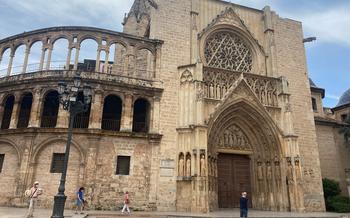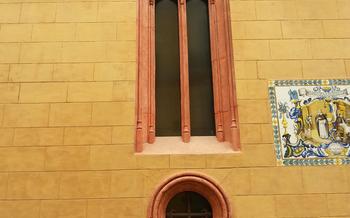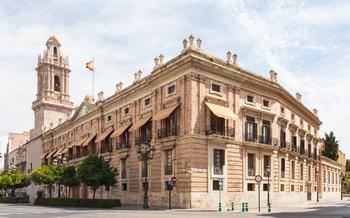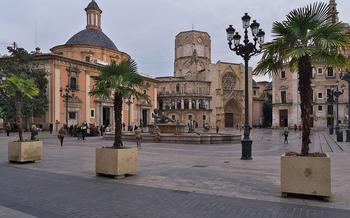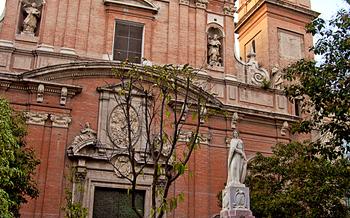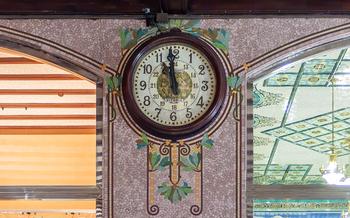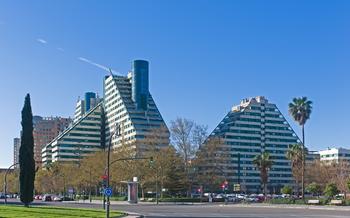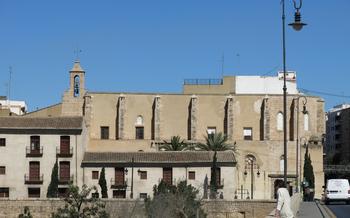
Iglesia del Patriarca o del Corpus Christi
- Exploring the Interior
- The Frescoes of Antonio Palomino
- The Altar of the Holy Chalice
- The Crypt: A Journey into the Past
- The Organ
- Guided Tours
- Accessibility
- Photography and Videography
- Dress Code:
- Hours of Operation:
- Admission Fees:
- Location and Transportation:
- A Hidden Gem Unveiled:
Exploring the Interior
Stepping inside the Iglesia del Patriarca o del Corpus Christi is akin to stepping into a realm of opulent beauty. The church's interior is a testament to the grandeur of the Baroque style, showcasing intricate details and lavish decorations at every turn. The walls and ceiling are adorned with intricate carvings, showcasing the remarkable craftsmanship of the artisans who worked on this masterpiece.
The centerpiece of the interior is undoubtedly the stunning altarpiece, a masterpiece of Valencian Baroque art. Created by renowned sculptor and architect José Esteve Bonet, the altarpiece is a symphony of marble, wood, and intricate carvings, depicting scenes from the life of Christ and the Virgin Mary. Its grandeur and artistry are truly awe-inspiring.
The church also boasts several chapels, each dedicated to a different saint and adorned with beautiful artwork. These chapels provide a glimpse into the rich history and diverse religious traditions of Valencia. Visitors can admire the intricate altarpieces, sculptures, and paintings that adorn each chapel, offering a deeper understanding of the church's significance.
The Frescoes of Antonio Palomino
The walls and ceilings of the Iglesia del Patriarca o del Corpus Christi are adorned with magnificent frescoes painted by the renowned Spanish artist Antonio Palomino. These stunning works of art depict biblical scenes and stories of saints, contributing to the church's rich visual tapestry.
Palomino's unique style and technique, characterized by vibrant colors, intricate details, and a mastery of perspective, bring the biblical narratives to life. His frescoes showcase his deep understanding of human emotion and drama, capturing the essence of each scene with remarkable accuracy and expressiveness.
One of the most notable frescoes is the "Triumph of the Eucharist," located in the main dome of the church. This awe-inspiring masterpiece depicts the heavenly glory of the Eucharist, surrounded by angels and saints. The vibrant colors and dynamic composition create a sense of movement and energy that draws the viewer's attention upwards.
Another highlight is the "Life of Saint Francis Borgia," a series of frescoes that narrates the life and miracles of the saint. Palomino's skillful storytelling and attention to detail bring the saint's journey to life, inspiring awe and devotion in the hearts of the faithful.
These frescoes are not merely decorative elements but integral parts of the church's spiritual and artistic heritage. They serve as powerful visual aids, helping the congregation to visualize and connect with the stories of the Bible and the lives of the saints. The frescoes of Antonio Palomino are a testament to his artistic genius and the enduring legacy of Baroque art in Valencia.
The Altar of the Holy Chalice
The Altar of the Holy Chalice is the centerpiece of the Iglesia del Patriarca and a revered site for pilgrims and believers worldwide. It is believed to house the Holy Chalice, a sacred relic that holds immense religious significance. According to tradition, this chalice was used by Jesus Christ during the Last Supper, imbuing it with profound spiritual energy.
The altar itself is a masterpiece of craftsmanship, adorned with intricate carvings, precious gemstones, and glistening gold. It serves as a fitting pedestal for the Holy Chalice, elevating its status as a symbol of faith and devotion. The altar is a testament to the enduring legacy of the church and the deep-rooted religious beliefs that shape the identity of Valencia.
The Holy Chalice has been a source of fascination and veneration for centuries, attracting pilgrims from far and wide who come to witness its sacred presence. Its authenticity has been debated and analyzed, but its symbolic importance remains unwavering. The chalice represents the enduring power of faith, the connection between the past and the present, and the deep reverence that permeates the atmosphere of the Iglesia del Patriarca.
Each year, during the grand Holy Chalice Procession, the relic is paraded through the streets of Valencia in a spectacular display of devotion. Thousands of faithful gather to witness this procession, which showcases the city's rich cultural heritage and its deep connection to its religious roots.
The Crypt: A Journey into the Past
Beneath the grand facade of the Iglesia del Patriarca lies a hidden treasure—the crypt. This subterranean chamber offers a glimpse into the past, revealing the rich history and legacy of the church. As you descend into the crypt, an atmosphere of mystery and reverence envelops you. The air is cool and still, and the only sounds are the faint echoes of footsteps and the gentle dripping of water.
The crypt serves as a final resting place for prominent figures associated with the church, each with their own unique stories to tell. Elaborate tombs and sarcophagi line the walls, adorned with intricate carvings and inscriptions that speak of their former occupants. Among the most notable is the tomb of Archbishop Juan de Ribera, the church's founder, whose remains lie in state beneath a majestic marble effigy.
As you explore the crypt, you can't help but feel a sense of awe and humility. These individuals, once so influential in their time, now lie in eternal repose, their earthly journeys complete. Their stories and contributions to the church's legacy live on, echoing through the centuries within these sacred walls.
The Organ
The Iglesia del Patriarca is home to one of the largest and most renowned organs in Spain, a masterpiece of musical craftsmanship that adds to the church's grandeur. Constructed in the 18th century by renowned organ builder Josep Bosch, this magnificent instrument boasts over 3,000 pipes, each meticulously crafted and tuned to perfection. Its intricate design and impressive size are a testament to the skill and dedication of its creators.
The organ's rich and powerful sound fills the church's interior, creating a truly immersive and awe-inspiring experience. It has been meticulously restored and maintained over the centuries, ensuring that its original beauty and functionality are preserved. Visitors can witness the organ's majesty during religious ceremonies, concerts, and special events, where talented organists showcase its versatility and power.
Whether you are a music enthusiast or simply appreciate the beauty of craftsmanship, the organ of the Iglesia del Patriarca is a must-see attraction. Take a moment to admire its intricate details, listen to its captivating melodies, and let the music transport you to another era.
Guided Tours
To fully appreciate the intricacies and history of the Iglesia del Patriarca, guided tours are highly recommended. These tours, led by knowledgeable and passionate guides, offer an immersive experience that brings the church's stories and significance to life.
Various tour options are available to cater to different interests and preferences. General tours provide a comprehensive overview of the church's history, architecture, and artwork. Thematic tours delve deeper into specific Aspekte, such as the life of Saint John of the Cross or the symbolism in the frescoes. Private tours offer a personalized experience, allowing visitors to customize their itinerary and receive undivided attention from their guide.
Booking a guided tour is easy and convenient. Visitors can reserve their spot online, by phone, or in person at the church office. Prices vary depending on the type of tour and group size, but generally range from 10 to 20 euros.
With a knowledgeable guide leading the way, visitors can gain invaluable insights into the church's hidden treasures and unravel the stories behind its walls. Whether it's learning about the symbolism of the frescoes, discovering the secrets of the crypt, or admiring the intricate details of the altarpiece, a guided tour enhances the experience and leaves a lasting impression.
Accessibility
The Iglesia del Patriarca is committed to providing an inclusive and accessible experience for all visitors. The church features several accessibility features to ensure that individuals with disabilities can fully enjoy their visit. Ramps and elevators are available to facilitate easy access to the church's interior, including the main sanctuary, chapels, and crypt. Wheelchair-accessible entrances are also provided to accommodate visitors with mobility limitations. For those with visual impairments, audio guides are available to enhance their exploration of the church's artwork and architecture. Additionally, the church staff is trained to assist visitors with disabilities and provide any necessary support. Visitors with specific accessibility needs are encouraged to contact the church in advance to inquire about additional accommodations or arrangements.
Photography and Videography
The Iglesia del Patriarca welcomes visitors to capture the beauty of its interior and exterior through photography and videography. However, to maintain the sacred atmosphere of the church, certain guidelines must be followed. Flash photography and tripods are prohibited to minimize disruptions during religious ceremonies and to preserve the artwork. Visitors are encouraged to be respectful and refrain from disturbing worshippers or blocking passageways while taking photos or videos. The church's stunning architecture, intricate details, and magnificent frescoes offer ample opportunities for capturing memorable images. Whether you're an amateur photographer or a professional, the Iglesia del Patriarca provides a picturesque backdrop for your creative endeavors.
Dress Code:
When visiting the Iglesia del Patriarca, it is essential to dress appropriately, as it is a place of worship and religious significance. Modest attire is expected, with shoulders and knees covered. Avoid wearing revealing or casual clothing, such as shorts, tank tops, or flip-flops. Visitors who are not appropriately dressed may be denied entry or asked to leave. Once, a tourist wearing shorts and a tank top was refused entry to the church, causing embarrassment and disappointment. It is important to respect the church's dress code as a sign of respect for the sacred space.
Hours of Operation:
The Iglesia del Patriarca o del Corpus Christi welcomes visitors with open arms, offering a serene and awe-inspiring experience. Its doors are open to the public from Monday to Saturday, from 10:30 AM to 1:00 PM and from 4:30 PM to 7:00 PM. On Sundays and public holidays, the church observes slightly different hours, opening from 10:30 AM to 1:00 PM and from 5:00 PM to 7:00 PM. It is recommended to plan your visit accordingly to avoid any inconvenience or disappointment.
To fully immerse yourself in the church's rich history and intricate details, guided tours are available during specific hours. These tours provide an in-depth exploration of the church's architecture, artwork, and religious significance. It is advisable to check the church's website or contact them directly for more information regarding guided tour schedules and availability.
Admission Fees:
Admission to the Iglesia del Patriarca is free for all visitors. This allows everyone, regardless of their financial means, to experience the beauty and grandeur of this architectural masterpiece. Visitors can explore the church's stunning interior, admire the intricate frescoes, and learn about its rich history without any financial barriers. The free admission policy encourages a diverse and inclusive environment, ensuring that everyone has the opportunity to appreciate this cultural and religious treasure.
Location and Transportation:
The Iglesia del Patriarca is conveniently located in the heart of Valencia's historic center, at Carrer del Patriarca It is just a short walk from other major landmarks, such as the Valencia Cathedral and the Plaza de la Virgen. To reach the church by public transportation, visitors can take bus lines 5, 6, 11, 28, 70, or 71, which all stop within a few minutes' walk. Alternatively, the nearest metro station is Colón, served by lines 3, 5, and For those arriving by car, there are several parking garages nearby, including the APCOA Plaza del Ayuntamiento and the Saba Plaza de Toros.
A Hidden Gem Unveiled:
Beyond its grand facade and intricate interior, the Iglesia del Patriarca holds a secret gem that often goes unnoticed by visitors. In a secluded corner of the church, tucked away from the main tourist paths, lies a small chapel dedicated to Saint Anthony Abbot. This hidden sanctuary is adorned with stunning frescoes depicting scenes from the life of the saint, rendered in vibrant colors and exquisite detail. Take a moment to seek out this hidden gem and immerse yourself in the beauty and tranquility of this sacred space.
